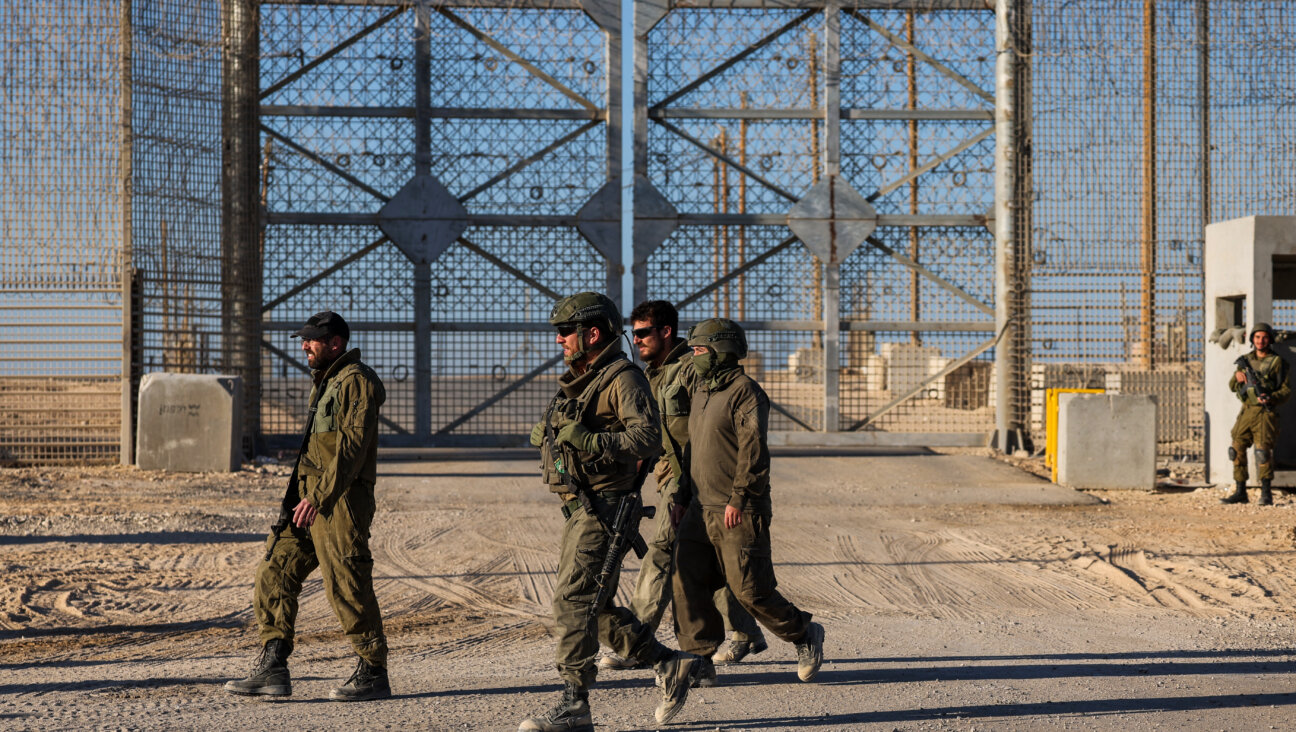Bush Drops Opposition To Building Of Barrier
WASHINGTON — The Bush administration has abandoned its opposition to Israel’s construction of a security fence in the West Bank, easing a major point of tension between Washington and Jerusalem in recent months, according to pro-Israel activists in Washington, Palestinian diplomats and sources close to the Bush administration.
Until this summer, the administration had vocally expressed its opposition to the fence, warning that its construction could hinder America’s “road map” peace plan. But with last month’s resignation of Palestinian Prime Minister Mahmoud Abbas, the administration now appears to accept not only the idea of the fence, but also its deep penetration into the West Bank.
The White House thinks Israel is justified in erecting the fence and that the Palestinian Authority has brought the fence on itself by not cracking down on terrorism, administration officials recently told pro-Israel activists. Furthermore, administration officials indicated that the Bush White House accepts the principle that security considerations in some instances necessitate allowing the fence to veer into the West Bank, the activists said.
“When there was a sense that the road map was a viable option, and that Mahmoud Abbas’s reformed government seemed to be in full bloom this summer, there was a sense in Washington that the mere existence of the fence was objectionable because it could hurt him,” said David Makovsky, a scholar at the Washington Institute for Near East Policy. “However, as these prospects faded, the debate [in Washington] very much has evolved from opposition to the mere existence of the fence to a more nuanced debate over the direction of the fence.”
A senior diplomat for the Palestinian Authority, speaking on condition of anonymity, characterized the American policy shift on the fence as “dramatic.” He explained that the administration’s concerns regarding the fence have shifted from political to humanitarian.
Before Abbas’s September 6 resignation, the Bush administration’s objection to the fence was political: Washington feared that the project would weaken the new Palestinian leadership; preclude the formation of a viable, contiguous Palestinian state, and predetermine the future borders of such a state. Now, the Palestinian diplomat said, Washington protests only when it finds the route of the fence objectionable, in cases such as the separation of Palestinian farmers from their land.
The Bush administration recently succeeded in persuading Prime Minister Sharon to halt plans to route the fence deeply into the West Bank to take in the large West Bank settlement of Ariel. But the administration seems open to the creation of a less intrusive enclave southwest of Ariel to accommodate what Israel says is its need for tactical depth to avert potential surface-to-air missile terrorist attacks against airplanes at Ben-Gurion international airport.
Israeli officials recently told their American interlocutors at the National Security Council that Israel needs full security control of a ridge located about three miles into the West Bank, near the Israeli settlement of Beit Arieh, in order to protect the airport. No attacks have been launched on the Lod airport from the West Bank, but Israeli security officials say that it is just a matter of time before Palestinian militants try to use handheld missiles to intercept aircraft flying in Israel. Terrorists made an attempt to shoot down an Israeli civilian aircraft in Kenya last November.
A team of experts from America’s Transportation Security Administration left this week for Israel to check the validity of Jerusalem’s claims.
The intense negotiations between Jerusalem and Washington over the route of the fence hardly involve the Palestinian Authority, according to sources familiar with the talks. “We are not very engaged or even consulted on those discussions,” said Michael Tarazi, legal advisor to the Palestinian Negotiations Affairs Department.
“We are very disturbed by that. Again we have a situation where Israelis and Americans are making decisions that Palestinians are going to have to pay for,” Tarazi said in a telephone interview from his Ramallah home.
In recent months, Palestinian officials met twice with Bush’s national security adviser, Condoleezza Rice. The most recent meeting, about a month ago, focused on the Palestinians’ concerns regarding two relatively short portions of the fence that Israel is building to seal off Jerusalem from Ramallah in the north and Bethlehem in the south, and not on other, longer portions of the fence that the Palestinians find objectionable.
A senior diplomat for the Palestinian Authority said the Palestinians have “hardly any real input” into the negotiations between Jerusalem and Washington over the trajectory of the fence.
The Palestinians had previously won the White House’s sympathy on the fence issue with a 10-minute computerized presentation delivered to Rice in Ramallah on June 28. The following day, Rice asked the Israeli Cabinet to “reconsider” the fence. President Bush, who referred to it as a “wall,” using the term preferred by the Palestinians, called it “a problem.” Secretary of State Colin Powell said the United States is “concerned when the fence crosses over onto the land of others.”
Pro-Israel advocates have recently stepped up their efforts in Washington to defend the fence project. Last week pro-Israel advocates held two separate events making Israel’s case for the fence, in the capital.
One event, hosted by the Washington Institute for Near East Policy, featured Major General Doron Almog, former commander of the Israeli army’s Southern Command, who was responsible for building the new security fence around the Gaza Strip three years ago. Speaking before an audience of Middle East experts, journalists and several Bush administration officials, Almog described in detail the fence he planned and built around Gaza and recommended that a similar model be used for the West Bank.
Almog, who is regarded as a leading candidate for the army’s deputy chief of staff post, emphasized the importance of creating a buffer zone on the Palestinian side of the fence. On the Palestinian side of the Gaza fence, Israel created a strip three-fifths of a mile wide, which was bulldozed and declared a no-go area for Palestinians. Those who enter have been arrested or shot, often fatally.
The buffer zone, Almog said, allowed the army to thwart infiltration attempts before terrorists reached the fence. Eight times in the past three years, terrorists did succeed in passing through the fence and were caught less than a mile into Israel’s territory. No suicide bomber from Gaza has been able to successfully execute an attack in Israel in the past three years.
Although the Gaza fence at 36 miles is less than one-fifth the length of the Green Line between Israel and the West Bank, and topographically less challenging, Almog told the Forward that “the same method can, without too much trouble, be replicated in the West Bank.”
A computerized presentation to a crowd of Middle East experts at the Middle East Institute, given by Rafi Danziger, who edits the biweekly newsletter of the American Israel Public Affairs Committee, was described by the senior Aipac official as an attempt to “balance” the Palestinian presentation that impressed Rice.
A message from our CEO & publisher Rachel Fishman Feddersen

I hope you appreciated this article. Before you go, I’d like to ask you to please support the Forward’s award-winning, nonprofit journalism during this critical time.
At a time when other newsrooms are closing or cutting back, the Forward has removed its paywall and invested additional resources to report on the ground from Israel and around the U.S. on the impact of the war, rising antisemitism and polarized discourse.
Readers like you make it all possible. Support our work by becoming a Forward Member and connect with our journalism and your community.
— Rachel Fishman Feddersen, Publisher and CEO






















